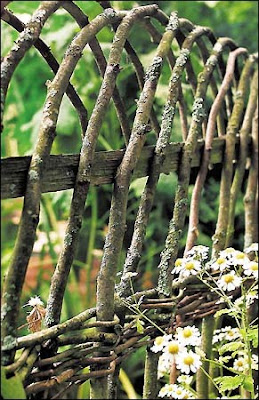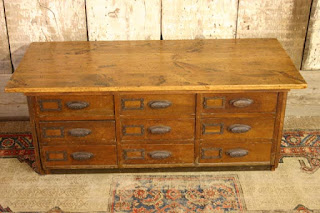Fences are some of my favorite things. They can be beautiful, they can be functional, and they can "set the stage" for what's inside. They can reinforce a community aesthetic. They are often used to keep chickens, children, pets, and strangers in or out. They protect gardens and provide privacy.
Most fences are pretty ordinary, ranging
from chain link to cedar pickets to concrete block, but every now and then you come come across a really fabulous example of someone's desire
not to be fenced in!
from chain link to cedar pickets to concrete block, but every now and then you come come across a really fabulous example of someone's desire
not to be fenced in!
Sometimes the "unconventional" fence is actually an old-fashioned hand-crafted fence, such as this wattle fence found in a Mother Earth News article.
Wattle fences are traditionally woven from fresh willow or hazel branches, but other fresh branches can also work. This article discusses how to recycle green waste into beautiful, functional fencing.
Another handcrafted fence we don't see a lot of anymore is stacked stone.
Typically, in areas where these fences were once common, stones were "harvested" from farmers' fields each spring, as freeze/ thaw cycles brought new stones to the surface. The stones were taken to the outside edges of the field and used to build mortarless stone walls. Held together by gravity, a dry-stacked wall can last for centuries with proper maintenance.
Occasionally, you see a fence that just makes you smile...
...like this fence made from old skis in a Colorado mountain town.
You have to admire the resourcefulness of the person who used old bed frames to build this fence.
And this fence made from re-purposed pressed and corrugated tin is a work of art!
This privacy fence was created using driftwood.
You don't necessarily have to use re-purposed material to create a fence that won't fence you in! An article in This Old House explains how to restore salvaged wrought iron fencing to create, well, fencing!
There are lots of ways to build a good fence. Maybe you will feel inspired by these ideas to think "outside the fence" when you are ready to plan your own project. You might think about incorporating unexpected, salvaged, or re-purposed materials to create a truly one-of-a-kind work of art!
This post is being linked to Alphabe-Thursday, over at Jenny Matlock's blog.
*photo of wrought iron fencing: Erik Johnson; first wattle fence photo: Lynn Karlin; Bed frame fence: Erik Rasmussen; driftwood fence: Nikolas Koenig
































